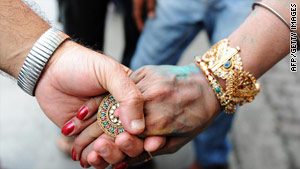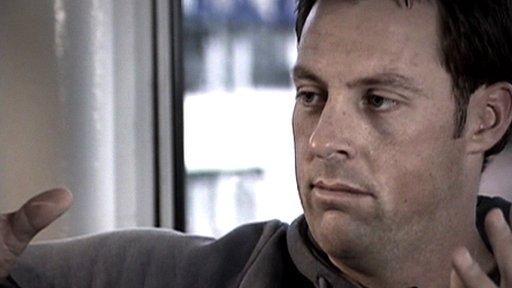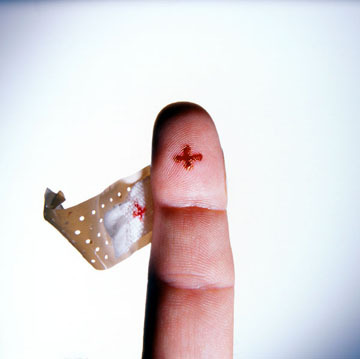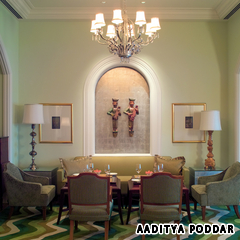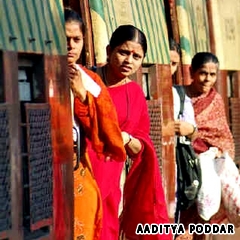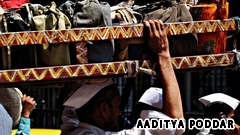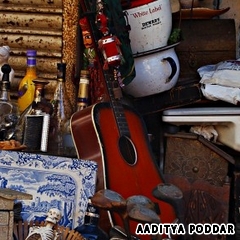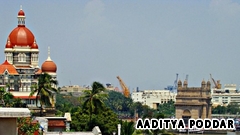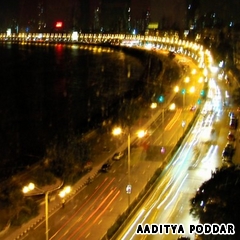Our Own Place for the Older lGBT–write to ashok kavi directly
Courtesy lgbtindia
From: arowkavi
> Date: Tue, 10 Nov 2009 07:32:01 +0000
> Subject: [lgbt-india] Our Own Place for the Older lGBT
>
> An LGBT Refuge and Old Age Home
>
> Everyone has a place in society and most of us must create one; we are different and diverse in culture, creed and color but most understand that our orientation is something unique only to us.
> Well, my little Prince, Manavender Singh of Rajpipla, has an old age home planned in Rajpipla but as an urban Indian, I’m not sure I want to end up in the backwaters of this great turbulent nation at the cross roads, far from immediate medical help. At the same time, I will not be a relegated to the past so easily. Not only will I be alone but I will also be lonely if I don’t have a partner.
> The concept of an Old Age Home for LGBT people has been discussed within the Board of Humsafar Trust, friends and colleagues across the spectrum. After studying some of the sad cases of gay men of means becoming bitter and badly-mannered faggots in their old age, it’s better to stop the slide downhill for our older brethren and that’s what this concept is all about.
> Can we have a communal living unit under one roof without the vulnerabilities of either being alone or lonely built out of the system? Yes we can if it’s well planned.
> This is an effort to do that – and its been shaping up over the last five years after talking to scores of people.
> If there are older LGBT people out on this list please write to me so I can share the concept and go forward with it seriously. I need a quorum of at least 25 to move this forward and I don’t think it’s too much to find them within our communities. Humsafar has always had a tradition of being innovative and pioneering in many ways. Maybe we can all pull this off with support from the Humsafar Parivar and INFOSEM.
> Thanks for reading this. So if you’re 55 or above, do write in and we can chat, exchange emails or meet to give shape to this project as soon as possible.
> Ashok Row Kavi
Email: moderator
Web Sites:
E Groups:
http://groups.yahoo.com/group/gay_bombay
http://groups.google.com/group/Gaybombay
GB Internet Radio
http://www.gaybombay.in/gbradio
Gaybombay breaking news and annoucements
http://labs.google.co.in/smschannels/subscribe/Gaybombay
Emergency Helpline number 9820565885
Orkut:
http://www.orkut.co.in/Main#Community.aspx?cmm=22091955
Blogs:
https://gaybombay.wordpress.com
The pressures of professional play (Gay Angle)
The pressures of professional play
| By Clare Murphy BBC News health reporter |

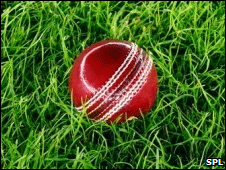
Every sport has its own particular pressures |
The suicide of German footballer Robert Enke has raised fresh questions about the particular pressures of sport on the psyche.
Every case is unique, and Enke had suffered intense personal tragedy with the death of his baby daughter from a congenital heart problem three years ago.
His widow Teresa said he had battled depression for years, and that he lived in fear the daughter they had subsequently adopted would be removed from them if his condition became public knowledge.
His career was also dominated by the extreme highs and lows that characterise sporting life.
A goalkeeper who was sidelined before finding favour again, he said openly that the threat of being usurped by a younger, better player made him falter, not flourish – and that it was faith in his talents that he needed to perform, not the challenge of competition.
After a stomach illness ruled him out of recent friendly internationals, a headline referred to his promised appearance in next year’s World Cup as the "comeback of the man thought dead".
Researchers have sought to unpick the various threads that may tie sport with suicidal tendencies. But the picture is a complex one, with each sport throwing up very different issues.
"We also have to keep this tragedy in perspective. There are particular pressures associated with sport but people do commit suicide – it is the most common form of death among young men," says sports psychologist Victor Thompson.
‘All consuming’
"We pay attention to this young man because he’s famous, but arguably many sports stars have access to the kind of support – from their team members, their club – that others could only dream of."
Mind Games – Inside Sport (UK users only)
Former cricket player turned writer David Frith does however believe there is something inherent to his sport which means English cricketers are apparently twice as likely to commit suicide as the average male.
"It is the all consuming nature of the sport, the number of hours you spend not necessarily playing but sitting around waiting to play – quite different to football say. You live and breathe it in a very intense, nerve-shattering way, and then very suddenly you’re spat out, it’s over," he says.
"But we’re also starting to see problems at the other end of the spectrum, when players are just beginning their career. In India in particular, where there is glamour and fervour akin to the English football premiership, we’re seeing youngsters take their lives as they realise they’re not going to go all the way."
The England career of cricketer Marcus Trescothick was ended by a stress-related illness, although he dates the onset of anxiety attacks back to when he was just ten years old.
Taking to the stand
The most high profile footballer to commit suicide in England was Justin Fashanu – the first professional footballer to admit he was gay.
 |
 You live and breathe it in a very intense, nerve-shattering way, and then very suddenly you’re spat out, it’s over You live and breathe it in a very intense, nerve-shattering way, and then very suddenly you’re spat out, it’s over
David Frith |
He was found hanging from the rafters of a London garage in 1998, at the age of 37. He was at the time facing a court charge in the US of sexually assaulting a teenage boy, and wrote in a suicide note that while innocent he felt he would be treated unfairly because of his homosexuality.
His career had already nosedived by the time he spoke about his sexuality, but to his own mind it was a deep-seated prejudice within the English game which led to his demise.
The consensus remains that the sporting arena remains a difficult place to be gay, but regardless of sexuality all athletes live under the constant threat of injury, pressure to perform, and early retirement in which the commentators’ box is not always an option.
 |
 I had clinical depression and I’ve probably had it all my life. It’s just that, for most of my life, I couldn’t admit to having something wrong I had clinical depression and I’ve probably had it all my life. It’s just that, for most of my life, I couldn’t admit to having something wrong 
Wendy Williams |
Injuries clearly take their psychological as well as their physical toll, but there is also growing evidence that head injuries may have a role to play in suicidal behaviour.
Chronic Traumatic Encephalopathy (CTE), associated with repeated blows to the head, is a risk for boxers and wrestlers – and has also been diagnosed in American football players – including two who had recently committed suicide.
Mind over matter
Chicken and egg theories also abound – and the question has been raised as to whether sport attracts a very particular type of personality.
There are athletes who have attained a high level of success in spite of psychiatric disorders such as manic depression, but also those who have perhaps chosen sport as a way of dealing with a problem like Attention deficit hyperactivity disorder, or ADHD, Antonia Baum, a psychiatrist at the George Washington University Medical Center, has argued.
Eating disorders, which are associated with suicide, may also have started as result of involvement in sports which require the leanest body possible.
The American Olympic diver Wendy Williams said she became preoccupied with finding a way to commit suicide before finally getting the help she needed.
"I had clinical depression and I’ve probably had it all my life. It’s just that, for most of my life, I couldn’t admit to having something wrong.
"I was an athlete. I was supposed to be able to get over it. Mind over matter."
Email: moderator
Web Sites:
E Groups:
http://groups.yahoo.com/group/gay_bombay
http://groups.google.com/group/Gaybombay
GB Internet Radio
http://www.gaybombay.in/gbradio
Gaybombay breaking news and annoucements
http://labs.google.co.in/smschannels/subscribe/Gaybombay
Emergency Helpline number 9820565885
Orkut:
http://www.orkut.co.in/Main#Community.aspx?cmm=22091955
Blogs:
https://gaybombay.wordpress.com
Britain Ready to Admit: No Good to Reason to Ban Gay Blood Donors
Britain Ready to Admit: No Good to Reason to Ban Gay Blood Donors
http://www.queerty.com/britain-ready-to-admit-no-good-to-reason-to-ban-gay-blood-donors-20091028/
That utterly retro policy that prevents gay men from donating blood? Britain is actually considering joining New Zealand, Spain, and Italy to overturn it. How come? Because as it turns out, the risk of letting men who have sex with men put their blood into a bank is effectively nil.
The scare tactic used to defend the ban surrounds a heightened infection rate among gay men. So, the thinking goes, keeping gay blood out of circulation, by default, cuts down on the possibility of infecting transfusion recipients. Except all blood is screened for HIV before it’s used — so why keep out healthy, willing gay donors?
There’s no reason: "While all blood donations are screened for HIV (human immunodeficiency virus), hepatitis B and C and syphilis before they can be used, very recent infections may not be detected. Health officials have argued that the only way to protect patients against this ‘window’ of early infections is through careful donor selection. Since 1985 only two patients have been infected with HIV through blood transfusions."
Email: moderator
Web Sites:
E Groups:
http://groups.yahoo.com/group/gay_bombay
http://groups.google.com/group/Gaybombay
GB Internet Radio
http://www.gaybombay.in/gbradio
Gaybombay breaking news and annoucements
http://labs.google.co.in/smschannels/subscribe/Gaybombay
Emergency Helpline number 9820565885
Orkut:
http://www.orkut.co.in/Main#Community.aspx?cmm=22091955
Blogs:
https://gaybombay.wordpress.com
‘Docs worst informed about homosexuality’
‘Docs worst informed about homosexuality’
http://www.mid-day.com/news/2009/oct/211009-Ashok-Row-Kavi-gay-activist-homosexuality.htm
| By: Hemal Ashar | Date: 2009-10-21 | Place: Mumbai |
As Mumbai gears up for a mammoth conference on sexuality, gay activist Ashok Row Kavi slams sexologists for their ignorance. Hemal Ashar referees a face-off
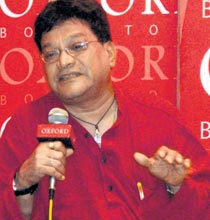
|
| What do they know? Ashok Row Kavi. file pic |
Ashok Row Kavi
Gay activist
"Doctors are the worst informed about homosexuality. At one talk, stupid questions like, ‘Are there injections to turn homosexuals into heterosexuals’ were thrown at me by docs. I answered with sarcasm.
I told them I know of injections that turn heterosexuals into homosexuals. They must understand human sexuality as a spectrum of different sexualities without being judgmental."
"Sexologist Dr Rajan Bhonsle, for instance, is homophobic. He claims homosexuality is a "choice" when it is a sexual orientation. Bhonsle wrongly equates same sex with anal sex.
A large number of gay men I know do NOT have anal sex. Bhonsle induces many homosexuals to go in for aversion therapy. His writings and lectures come in the way of creating a more tolerant and healthy society."
Dr Rajan Bhonsle
Head of the dept of sexual medicine at KEM Hospital
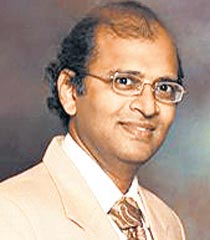
|
| WHO IS HE ACCUSING? Dr Rajan Bhonsle. file pic |
"Kavi calls me homophobic, but has he read my writings or listened to my lectures where I have said that every person of any sexual orientation has equal rights? I have not stated that homosexuality is only a choice, only said that there are certain unknown factors that might make a person veer towards it. I have never stated that all gay men have anal sex and have also said that heterosexuals too have anal sex.
"I do not believe in aversion therapy. Only if an individual, who approaches me, has the right reasons, and a willingness to develop orientation towards the opposite sex, do I help him. I have hundreds of patients who have developed heterosexual orientation following therapy and are now happily married."
Sex mahamela
The 25th National Conference of Sexology by the Council of Sex Education & Parenthood International (CSEPI) in partnership with the Indian Andropause Society (IAS) and Andrology India will be held from October 23 to 25 at the Nehru Centre, Worli. About 200 doctors from across India are expected to attend this event.
Is homosexuality an orientation?
Homosexuality is definitely an orientation. but homosexuals can change their orientation; they can become bisexuals. Also, some medicines, along with psychotherapy and cognitive behaviour therapy, may be used to change their orientation. I would not term homosexuals as abnormal or mentally ill, but I do think their orientation defeats the purpose of human evolution.
– Dr Madhav Pakhare, psychiatrist and sexologist
Homosexuality is an orientation, it is genetic. No medicine can change orientation. Though we do not need to promote homosexuality by saying homosexuals are more creative and all that nonsense, gays need to be accepted and respected. All these medicines and tonics in the market designed to change orientation just exploit the desperate.
– Dr Prakash Kothari founder, professor, dept of sexual medicine, KEM Hospital
Email: moderator
Web Sites:
E Groups:
http://groups.yahoo.com/group/gay_bombay
http://groups.google.com/group/Gaybombay
GB Internet Radio
http://www.gaybombay.in/gbradio
Gaybombay breaking news and annoucements
http://labs.google.co.in/smschannels/subscribe/Gaybombay
Emergency Helpline number 9820565885
Orkut:
http://www.orkut.co.in/Main#Community.aspx?cmm=22091955
Blogs:
https://gaybombay.wordpress.com
Transformation, Emancipation
| Transformation, Emancipation |
| Written by Hira Nabi |
| Sunday, 18 October 2009 03:17 |
| On July 2nd, 2009, the Delhi High Court ruled that the law outlawing homosexual acts was discriminatory and a “violation of fundamental rights.” The ruling overturns a 148-year-old colonial law, which describes a same-sex relationship as an “unnatural offence.” The recent ruling decriminalising homosexuality in India, being touted as India’s Stonewall, is generating debate and controversy. This ruling comes at a time when there is much unrest and agitation around the notorious Proposition 81 and other lesser-known rulings around hate crimes and non-discrimination acts and marriage rights.
A piece of legislation insofar as it remains encoded in legality is not of much use. Granted, it provides recourse to law and aims to safeguard rights and protect from vulnerability those whose rights have been dispossessed. In this case, homosexuals and transgendered peoples, who have been Other-ed by the draconian laws written into existence by bigotry and privileged intolerance. Securing human rights, however, remains a process. New rulings and laws must be accompanied by social campaigns that must explain and create acceptance and understanding around new unprecedented pieces of legislation. The judicial framework even remains inaccessible to many. How can this ruling be extended beyond red tape bureaucracy and provide a real solution to the queers and non-straight-identifying people of India? At the same time, credit must be given where it’s due. The fact that the Delhi High Court was able to overturn this ruling is proof of a vibrant and clamorous lobby for queer rights. It is of course an indicator of the change in the Indian society and state, towards granting rights and protections to queers. While it is clear that LGBTQ organizations and activists have been advocating rights for homosexuals for a long time, the State must now build upon those efforts through the legal framework (initiated on July 2nd) to make this change more palatable. Essentially, the new queer movement seeks to broker alliances across all kinds of social binaries, of gender, sexuality, class, race, ability and create a wide range of opposition to counter the status quo. It needs to and has broken away from old patterns in which there no alliances between gay men and lesbians. The idea of ‘queer’ as imagined by radical activism and organising challenges to heterosexism, though a movement built by the collective experiences of all those who have been Other-ed and their allies. This battle is being waged to deconstruct the existing power dynamics by challenging the heteronormative ideology to be able to garner meaningful change. Despite the collective and coalitionist nature of this movement, ‘India’s Stonewall’ seems to be set in celebrating and protecting only gay men. Where are the voices of the lesbians and the transgenders? Where indeed are the queers? There has been a lot of publicity around gay men and gay activists and organisations that support homosexual men, and indeed a lot of anger too; however, men have dominated the discourse. In conservative patriarchal societies it is difficult to be a gay man. Coming out requires a great deal of courage, a lot of patience and indeed a lot of love. As Che Guevara famously said, “a true revolutionary is guided by great feelings of love.” To be queer is tantamount to heralding a revolution. Yet, female-identified, female-bodied and transgendered people have all been sidelined and excluded from this revolution. Gay men are socially ostracised, stigmatised, attacked and murdered at worst; tolerated at best; and in some few cases, accepted. It is however, lesbians and female-bodied people who do not identify as straight that cannot be tolerated. Male privilege must not be forgotten when it comes to the oppression of heterosexism upon those who exist on its margins. Is it is easier to be a man and to be gay than to be a woman and to be gay? Governed by mores where it is socially inconvenient and a social liability to be a single woman, it is at times unthinkable to be a woman loving or living with another woman in a society that has grown old and rigid in enforcing different standards of acceptable and appropriate behaviour for men and women. However, is it even judicious to be asking such reductive questions? I was made to re-think the need for this question through an email conversation with a friend who pointed out the “unique violence and threatening nature about the inherent machismo quality within societies that makes coming out as gay for men particularly affronting.” We need to measure the different impact of heterosexist norms upon queer male bodies as opposed to queer female bodies, however to create yet another hierarchy would be conceding the battle. It has been argued that privilege can be manipulated in a radical way to use that space and visibility to the movement’s advantage. I have my own concerns about this as this strategy can oftentimes fail in its methods and instead reinforce the existing system by pandering to its hierarchies instead of deconstructing them. However, insofar as this can be empowering and empathetic, it should remain a part of organizing and activism. In conservative patriarchal societies, it is often noted that it is not just homosexuality that is closeted; heterosexuality also needs to come out into the open. It is clear that this is as much an issue of social emancipation and raising social consciousness, as legal rulings. It is an issue that must not abandon or isolate the lesbians or the trans communities in favour of those who are male-bodied and male-identified and indeed male-privileged. This is a movement for all of us, queer or straight, male or female, cis or trans, gender conforming or genderqueer, to come together and challenge the existing paradigm. |
Email: moderator
Web Sites:
E Groups:
http://groups.yahoo.com/group/gay_bombay
http://groups.google.com/group/Gaybombay
GB Internet Radio
http://www.gaybombay.in/gbradio
Gaybombay breaking news and annoucements
http://labs.google.co.in/smschannels/subscribe/Gaybombay
Emergency Helpline number 9820565885
Orkut:
http://www.orkut.co.in/Main#Community.aspx?cmm=22091955
Blogs:
https://gaybombay.wordpress.com
Gujarat gets India’s first old age home for gay men
Gujarat gets India’s first old age home for gay men
- image0015
- image002
 Published on Mon, Oct 12, 2009 at 15:23, Updated on Mon, Oct 12, 2009 at 15:54 in India section
Published on Mon, Oct 12, 2009 at 15:23, Updated on Mon, Oct 12, 2009 at 15:54 in India section
New Delhi: Taking a boost from the Delhi High Court’s verdict on legitimising homosexuality, Gujarat has become the country’s first state to have an old age home for gay men.
A home for the gay men has been started by Lakhsya, an NGO working on rights for the gay community in the city of Vadodara.
Sixty-year-old gay man, Somabhai lived through years of ridicule and ostracism from the conservative Gujarati society but now in his twilight years, he’s has found friendship and “I feel very happy to be here, I like living here,” says Somabhai.
Now many like him can look forward to an old age shelter exclusively for homesexual men.
The brainchild of Manvendra Singh Gohil, popularly known as India’s gay prince, the project will be ready to accommodate elderly homosexuals by the end of the year.
Manvendra Singh Gohil says, “We will offer food, drinks and medical facilities for the people staying here, it will be their home.”
The Rs 25-crore project will be home to 50 elderly gay men to start with. Requests for accommodation have already started trickling in.
Email: moderator
Web Sites:
E Groups:
http://groups.yahoo.com/group/gay_bombay
http://groups.google.com/group/Gaybombay
GB Internet Radio
http://www.gaybombay.in/gbradio
Gaybombay breaking news and annoucements
http://labs.google.co.in/smschannels/subscribe/Gaybombay
Emergency Helpline number 9820565885
Orkut:
http://www.orkut.co.in/Main#Community.aspx?cmm=22091955
Blogs:
https://gaybombay.wordpress.com
American gays looking to Indian surrogate industry to have children
http://www.littleabout.com/news/39095,american-gays-indian-surrogate-industry-children.html
American gays looking to Indian surrogate industry to have children
Washington, Oct.12 – ANI: American couples, especially gay men, are having children abroad for less money and with fewer headaches, and India, it seems, has emerged as the ideal surrogate mom destination, according to a report.
According to the report appearing in the website www.the dailybeast.com/blog, Indian surrogacy is now a half-billion dollar industry.
It mentions the case of Mike Griebe and Brad Fister, who tried everything to have a child. They explored adoption. They researched what Griebe termed "a baby factory type deal," where you basically pay for a "ready-made baby." They went to agencies that promise to find babies in the United States.
The Kentucky couple even paid 20,000 dollars to a Virginia woman to be a surrogate, only to walk away when she insisted that if anything happened to Griebe, 38, and Fister, 30, that she would have rights to the baby.
Then, one day, while watching Oprah, they heard about a relatively new way to have a child: using an Indian surrogate.
The segment featured Dr. Nayna Patel, the director of the Akanksha Infertility and IVF Clinic in Anand, Gujarat,India.
At first, Griebe and Fister didn’t think an Indian surrogate would be an option.
"We just dismissed it because when we searched it, we found that that clinic would only deal with traditional couples," says Griebe meaning straight couples.
After searching online, they came across the Web site for Surrogacy Abroad, a Chicago agency run by Benhur Samson that guides foreign couples through the process of hiring a surrogate mother in India.
After talking with Samson and an embryologist in India, the couple drove to Chicago to meet with Samson.
"We felt very comfortable with him, unlike everybody else we had dealt with after that time," says Griebe.
The two decided to use Fister’s sperm for the pregnancy, and so he flew to India with Samson. Fister met his surrogate who, he says, is married with two children and told him the money she’s making from the surrogacy will go toward her children’s education.
Fister says he was surprised at how open the clinic was.
"The whole process was a lot more hands-on than it would be in the U.S.," he says. "You get to see the whole process. I got to watch the embryos go in. Those are things you never get to see here. You follow them the whole way." After one failed attempt and one miscarriage, their surrogate is now due in April.
They get updates, including ultrasounds, via email.
Samson, a native of India, started Surrogacy Abroad in 2006, when one of his sisters was having trouble getting pregnant. He’d worked in the medical field for 22 years, processing claims and benefits, before starting the agency.
"I flew to India and checked out all the clinics," he said, before finally settling on Kiran. Commercial surrogacy was legalized in India in 2002, and it is now estimated to be a 445 million dollar business.
Griebe and Fister say they’ve spent around 40,000 dollars on the surrogacy process so far. According to Samson, 8,000 dollars goes directly to the surrogate mother.
Samson’s agency is one of the few to specifically target gay couples.
Homosexuality was only decriminalized in India in July; even though it was rarely prosecuted, it was still a social taboo until a few years ago.
It’s illegal for surrogates to be recruited directly by the hospital. Instead, they’re found by a social worker at an NGO, according to embryologist Samit Sekhar.
"A year ago, I would have said it was very difficult to recruit a surrogate," says Sekhar. "Now it is becoming much more open. They get a decent amount of money. They get free food, free boarding, and free clothes, and they are housed in a nice place" for 12 months, away from their families.
Sekhar says that Kiran can house up to 50 surrogates at a time. "They stay at the clinic. The non-pregnant surrogates are housed in an apartment," he says. – ANI
Email: moderator
Web Sites:
E Groups:
http://groups.yahoo.com/group/gay_bombay
http://groups.google.com/group/Gaybombay
GB Internet Radio
http://www.gaybombay.in/gbradio
Gaybombay breaking news and annoucements
http://labs.google.co.in/smschannels/subscribe/Gaybombay
Emergency Helpline number 9820565885
Orkut:
http://www.orkut.co.in/Main#Community.aspx?cmm=22091955
Blogs:
https://gaybombay.wordpress.com
World’s Greatest City: 50 reasons Mumbai is No. 1
World’s Greatest City: 50 reasons Mumbai is No. 1
Pachyderms, produce and perseverance — you can find it all in the streets of India’s commercial capital, along with some of the most colorful culture imaginable
http://www.cnngo.com/mumbai/none/worlds-greatest-city-50-reasons-why-mumbai-no-1-809212
Tell others what you think!
This list was compiled and written by Mumbai cool hunters Kanika Parab and Mansi Poddar, founders of the Brown Paper Bag website
1. Most romantic home furnishings
Since the 1950s, the old corner couch at the posh Taj hotel’s Sea Lounge has been where moneyed Mumbai introduces suitable boys and girls for marriage. The lucky velvet sofa is no ordinary love seat — it’s big enough to couch mummy, aunty and whomever else is in on the plot.
Sea Lounge, Taj Mahal Hotel & Palace, Apollo Bunder, Colaba, tel +91 (0) 22 6665 3366
2. The amazingest race
Spanning 1,900 kilometers from Chennai to Mumbai, the Rickshaw Challenge is an “amazing race for the clinically insane.” The 13-stage event requires auto rickshaw drivers to navigate hills, valleys, beaches and, of course, jam-packed city streets. Those seeking to learn how to operate the two-stroke workhorse of the Indian commuter system — the ‘beautiful beasts’ first rolled off Indian assembly lines in 1957 and have barely changed since — can take lessons and register for free at the link above.
3. Women travel handprint-free
It might sound like the title of your next book group novel, but the Ladies Special local train pulls into the Gothic-style Chhatrapati Shivaji Terminus station (which noobs mistake for a huge cathedral) at 10:09am every morning. Of the thousand trains that run daily through the historic station, the Ladies Special is a sanctuary for some 35,000 working women who don’t fancy being groped on their way to the office. On the 5:55pm ride back home, the Ladies Special turns into a portable kitchen with mums peeling vegetables, a communal office for laptoppers, a mobile shopping center, a meditation and prayer room and whatever else it need be to accommodate the endless demands placed on India’s tireless working women.
Chhatrapati Shivaji Terminus, Dr. Dadabhai Naoroji Road, Fort, tel + 91 (0) 22 269 5959
4. Porn the whole family will love (to scurry past quickly)
Pressed between the brothels and skin and sex therapy clinics of Grant Road, the Pila Haus cluster of colonial-era cinema halls — such as the Theatre Royal, Alfred Cinema, Gulshan Cinema and New Roshan — screen Bollywood films from the 1980s and 1990s for as little as Rs 15 a pop. Originally playhouses for the British, they were named ‘pila’ because locals couldn’t pronounce ‘play.’ Following independence, the stately halls showcased Parsi theater and Marathi tamashas. But these days, amid pulsing red-light distractions, the main draws are tales of puppy-love romance, such as Sanjay Kapoor’s “Sirf Tum.”
5. A million-dollar baby … elephant
This infant is 12 feet tall, his name is Lalbaugcha Raja and he is the king of Mumbai’s annual 10-day Ganesh festival in September. During the festival, more than two million Hindu devotees throng to see the wish-granting idol of the infant elephant god, which was insured for 25 million rupees this year. Devotees collectively donate Rs 5 crore and more than 5,000 sacks of coconuts each year, then follow the Raja on a procession toward Chowpatty beach, where he’s immersed in the sea.
Lalbaugcha Raja Sarvajanik Ganeshotsav Mandal, G.D. Ambedkar Marg
6. The original Cavern Club
Each February, an antiquated ferry runs from the Gateway of India to the UNESCO World Heritage site of Elephanta Caves on an island in the Sea of Oman. That’s where music fans gather for the annual Elephanta Festival, where Indian classical music maestros such as Zakir Hussain and Ravi Shankar rock on amid a collection of ancient rock art dedicated to the cult of Shiva.
7. A brand new paint job
People are always grumbling about making Mumbai prettier. On Independence Day 2009, the graffiti artists of The Wall Project did it, covering a 2.7-km stretch of wall along Tulsi Pipe Road with colorful spray-painted art mixed with slogans promoting social causes — all with the municipal corporation’s cooperation. Chronicling Mumbai’s contemporary culture, the Tulsi Pipe graffiti joins the vibrant seaside mural adorning Sassoon Dock’s high-cement boundary and Mario Miranda’s caricatures of Mumbai beer drinkers on the walls of Café Mondegar.
Café Mondegar, Metro House, near Regal Cinema, tel +91 (0) 22 2202 0591
8. Our chefs don’t want you to die
Mumbai may be cuckoo for sushi and fugu, but many still bow down to traditional fare, eating well to live well. At Swadshakti Café, Mumbai’s only Ayurvedic restaurant, the Panchakarma Thali, with five saatvik vegetarian dishes is cooked with healing herbs — and without oil, garlic or onions. Designed to detox, the menu was created by Dr. Smita Naram to put her chunky husband, Pankaj, on a healthy path — and it’s a proven winner.
Swadshakti, Bhadran Nagar Cross Road 2, opposite Milap Cinema, Malad (W), +91 (0) 22 2806 5757
9. Illiterate business gurus
Prince Charles and Richard Branson have met with Mumbai’s famous dabbawala lunch deliverymen to learn how 200,000 identical steel lunch canisters (‘dabbas’) are transported by 5,000 mostly illiterate deliverymen from the homes where the humble lunches are made to offices and workers around town — daily, punctually and with barely one error in every six million deliveries. Dabbawalas now give management lectures at top Indian business schools, explaining how the 125-year-old dabbawala industry continues to grow at a rate of five to 10 percent a year.
The Dabbawala Foundation is currently developing software that will allow users to book dabba lunch delivery online. In the meantime, you can email info to sign up for service.
10. Most prolific film industry in the world
Compared to Hollywood, the Hindi-language film industry based in Mumbai produces nearly 200 more films a year, each almost 50 percent longer, on a fraction of the budget, with more color, more melodies and more melodrama. And Bollywood’s even starting to steal stars from its Western counterpart. One billion moviegoers can’t be wrong.
11. Potatoes are religion (and politics)
They’re fast, cheap and political. Every day thousands of vada pav (potato dumplings) are fried and deftly placed in pav bread quickly enough to keep up with Mumbai’s voracious appetite. The fiery red chutney that goes with vada pav can be risky — not unlike Shiv Sena, the local political party that has made Mumbai’s five-rupee signature street snack its mascot. It’s hard to go wrong with vada pav, but we love the ones at a stall called Ashok, off Cadel Road, Kirti College Lane, Prabhadevi.
12. Yoga for the face
If you live near a rare patch of park in Mumbai, chances are you’ll wake up to the sounds of laughter. That’s because every morning, members of the city’s 87-odd Laughter Yoga clubs gather in green spaces to guffaw. Founded by Mumbai physician Dr. Madan Kataria in 1995, laughter yoga is based on scientific research that shows the body cannot differentiate between fake and real laughter. You get the same physiological and psychological benefits whether you find something funny or not.
13. A bridge worth its weight in elephants
Our brand-new Bandra-Worli Sea Link bridge took 10 years to complete, but now that it’s here we can hardly remember the near-hour it once took to travel between Mumbai and the western suburbs. For the 25,000 vehicles that use the bridge each day, the trip now takes about seven minutes. With main towers as high as a 43-story building, the 4.7km bridge weighs as much as 50,000 African elephants and the steel wire used can nearly wrap around the circumference of the earth. The Times of India described it best: “Heavy-duty beauty.”
14. Stickiest wickets
The Dr. H.D. Kanga League combines two of Mumbai’s greatest loves — cricket and heavy rain. Perhaps that’s why the league has never taken a season off since being founded in 1948. Touted as the only tournament to be held during the monsoon — heroic batsmen with muck-splattered faces, valiant fielders slogging through flooded outfields — the Kanga League has been the muddy battleground beginning for some of India’s biggest cricketing stars, including Sachin Tendulkar.
15. Art deco cinemas
Talk to anyone who lived in Mumbai before the multiplex deluge and they’ll get all gulpy about the single-screen art deco cinemas that once dominated the movie scene here. With its rococo artwork and ethereal lighting, Liberty Cinema is the most popular and publicized vestige of bygone Bombay elegance. But we’re suckers for the soaring entryways, peeling powder-blue walls and delicate white-and-gold scrollwork at Bharat Mata theater.
Liberty Cinema, Marine Lines, +91 (0) 22 2203 1196 Bharat Mata, Parel, +91 (0) 22 2470 9181
16. Maximum panorama
Opening in November 2009, the rooftop bar at the Four Seasons hotel offers an amazing vista of the iconic Mahalaxmi Racecourse, the Arabian Sea, Haji Ali, the Worli-Bandra Sealink and acres of slums and old mill areas. Maximum city in a single eyeful.
Four Seasons, 114 G Babu Sakpal Marg, tel +91 (0) 22 2481 8000
17. Buy your stolen stuff back cheap!
From a replacement for your chipped antique Wedgewood demitasse cup to the Mercedes Benz hood ornament that was yanked off your car, the most bizarre jumble of antiques, spare parts, Bollywood posters and electronics in Mumbai can be found at grimy Chor Bazaar (Thieves Market), so called because it’s assumed many of the goods for sale are stolen. Take along your bargaining skills and leave your claustrophobia (and morals) at home.
Get started at Mini Market, 33/31 Mutton Street, Chor Bazaar, Mohammed Ali Road, tel +91 (0) 22 2347 2427
18. Drinking holes that don’t dry up
Pretty relics of Mumbai’s colonial past, the Willingdon Sports Club and Cricket Club of India have always laid an elegant tea. Patrons sit in cane chairs by the lawns where cricket and golf are played, old money talks and the waiters are hard of hearing. Along with five-star hotels, these old Mumbai institutions are the only places that serve alcohol on ‘dry’ days — and, best of all, at prices that, too, have not kept up with the times.
Cricket Club of India, Brabourne Stadium, Churchgate, tel +91 (0) 22 6659 4252
Willingdon Sports Club, K Khadye Marg, Tulsiwadi, tel +91 (0) 22 2354 5755
19. Sweetest 200-rupee tourist view and dessert
Sesame-sprinkled honey noodles with vanilla ice cream at the Bay View Terrace Bar sweeten the already rich view that takes in the curving bay, the Taj hotel’s heritage wing dome and Mumbai’s most famous monument, the Gateway of India, right at the tip of our narrow island.
Bay View Terrace Bar, Hotel Harbour View, Kerawalla Chambers, opposite Radio Club, Apollo Bunder, Colaba, tel +91 (0) 22 2282 1089
20. Party like it’s 1909
Mumbai’s textile mills were an important part of India’s manufacturing history. And in the Lower Parel district, factory commerce is still alive, albeit with music and mojitos, in the stretch of bars that has sprung up inside converted mills. At Shiro, Hard Rock Café, Blue Frog and Zenzi Mills, the sound is banging (that’s good), because each venue has preserved the industrial-sized ceilings and post-modern factory feel. After all these years, it’s still the best place to spin.
Shiro, Bombay Dyeing Mill Compound, Pandurang Budhkar Marg, Worli, tel +91 (0) 22 6615 6969
Hard Rock Café, Bombay Dyeing Mill Compound, Pandurang Budhkar Marg, tel +91 (0) 22 6615 5959
Blue Frog D/2 Mathuradas Mills Compound, N.M. Joshi Marg, Lower Parel, tel +91 (0) 22 4033 2300
Zenzi Mills, Todi Mills Compound, Tulsi Pipe Road, Lower Parel, tel +91 (0) 22 4345 5455
21. World’s most expensive home
Soon, Mumbai will house the highest-priced residence in the world. Local tycoon Mukesh Ambani’s US$2 billion, 27-floor skyscraper Antilla will reportedly have three helipads, six floors of parking and 600 full-time staff. That beats even Marine Drive’s three-kilometer strip of land where, at Rs 40,000 per square foot, one jewel in what’s known as the Queen’s Necklace can cost Rs 100 crores.
22. Complete and utter silence
Mumbai never stops squawking, but inside the walls of the Dhamma Pattana Vipassana Centre, conversation is completely verboten. The center’s newly built Global Pagoda stores important relics of Buddha and hosts a meditation camp that forbids participants from speaking — or watching TV, listening to music or reading — for the entire duration of the 10-day beginner’s course. ‘Vipassana’ means “to see things as they really are.” Founder S.N. Goenka — a Burmese sugar and textiles entrepreneur born in 1924
